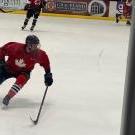-
Content Count
3690 -
Joined
-
Last visited
-
Days Won
176 -
Feedback
100%
Content Type
Profiles
Forums
Downloads
Gallery
Store
MSH News and Articles
Everything posted by VegasHockey
-

Quality of Superfeet over the years
VegasHockey replied to iceman8310's topic in Ice Hockey Equipment
They seem the same to me. -
Golden Gate is good. Glen at Storeyline Hockey is also fantastic https://www.storeylinehockey.com, and he has an engineering background in aeronautics, everything with him is all about tolerances. Otherwise, on the West Coast (CA, OR, WA, NV, UT, AZ, I would not let anyone else touch my steel. They either don't give level edges, burn it, round off the heel or toe, wreck the profile., or do one skate with 20 passes and the other with 10 passes, changing the height between blades.
-

Sparx Skate Sharpener - At home sharpener
VegasHockey replied to tamtamg's topic in Ice Hockey Equipment
There are already machines that self calibrate, however those are at the commercial level and use lasers to make adjustments at the micron level. They are also not easily accessible for most individuals since they are very expensive and many stores are already invested in "big machines" like Blademaster, Blackstone, ProSharp, etc. Those stores need to wait for the deprecation of their current hardware to drop so it makes sense to purchase new machines. Almost all high quality steel produced currently is roughly 2.95 - 3.02 mm in width. Usually ones with a PVD coating, such as DLC or TI, are on the wider side due to the coating. However, with good brands, like STEP, and JRZ, even those are well within tolerance. I check every pair I sharpen with a micrometer and log it on a sheet. Some older and lower quality steel falls outside that measurement, but only marginally. The self-centering clamp on the Sparx was actually their best innovation. ProSharp and other developer a self-centering clamp, but their overall clamp and machine design had too many flaws. SSM has a self-centering clamp on their hand machine which also works very well, but that machine has many other issues such as wheel calibration and is only as good as the operator. Typically, unless the steel is bent, damaged, or low quality, it should be within the tolerance and the machine should not require adjustment. Most hand sharpening machines use a jig, the weight of the boot plus clamping mechanism can change the outcome of the sharpening which requires a knowledgeable operator. Let's just focus on the edges, not on finish, and the hand sharpening process, which is all dependent on the operator and his overall performance. So, back to the matter at hand. Many times, people take measurements before they deburr a blade, which also can yield incorrect results. They then make adjustments to their machine and end going back and forth, overshooting a level edge, when 99% of the time it was most likely perfect to begin with. IMO, the issue isn't we need more tools. A micrometer and right angle work fine. They have for centuries. You wouldn't have most modern engineering if these items didn't work. The problem is we need better education for users. /end rant -

Skate blade pouch- 4 sets of blades
VegasHockey replied to iceman8310's topic in Ice Hockey Equipment
You should. I would be your first customer 🙂 -

Skate blade pouch- 4 sets of blades
VegasHockey replied to iceman8310's topic in Ice Hockey Equipment
Thats a nice one too! -

Sparx Skate Sharpener - At home sharpener
VegasHockey replied to tamtamg's topic in Ice Hockey Equipment
I don't see any of the problems they are trying to solve as legitimate and actual problems. The alignment worked fine for a majority of people. The edge checker also worked fine. I don't see a need for an app for a machine that is very basic and can basically run off firmware. They are solving for concerns that aren’t tangible IMO. It not like Skatescribe or Elite where you need OTA software as those are industrial machines that are software driven doing profiling and sharpening. -

Skate blade pouch- 4 sets of blades
VegasHockey replied to iceman8310's topic in Ice Hockey Equipment
I used to have one and loved it. When you roll it up, it condenses nicely. -

Skate blade pouch- 4 sets of blades
VegasHockey replied to iceman8310's topic in Ice Hockey Equipment
ProSharp used to make a roll-up carrying case that could hold 12 pairs of steel. You may want to try to find one on SidelineSwap or Ebay. -

Sparx Skate Sharpener - At home sharpener
VegasHockey replied to tamtamg's topic in Ice Hockey Equipment
Not impressed with the new product. -

Skate blade pouch- 4 sets of blades
VegasHockey replied to iceman8310's topic in Ice Hockey Equipment
4 sets, as in 8 blades total? -
Sent you a PM.
-
What area are you specifically? CA? AZ? CO? NV?
-
The cost to repair is going to be the same or more than buying a new skate. The TF7 has been on closeout pricing for a little while.
-

myBauer Re-Akt Helmet - 3D Printed Digital Foam
VegasHockey replied to walkerdb7's topic in Ice Hockey Equipment
99% of customers I have dealt with always do a mirror test. I totally get it. I'll poke around and see if I can find any data on what pro players, if any, are using it. -

myBauer Re-Akt Helmet - 3D Printed Digital Foam
VegasHockey replied to walkerdb7's topic in Ice Hockey Equipment
Many pros are wearing the Tacks X custom helmet and can't say I have seen any wearing the custom Bauer helmet. FWIW, I know quite a few pro equipment managers and they also haven't seen any of their players using the custom Bauer helmet. -

myBauer Re-Akt Helmet - 3D Printed Digital Foam
VegasHockey replied to walkerdb7's topic in Ice Hockey Equipment
Tried this helmet and it was pure garbage. If anyone is going to spend serious money on a custom helmet, get the Super Tacks X. It's comfortable, protective, and breathes nicely. -
I must be blind. I don't see anything abnormal.
-
Tested the T8 Pro, didn't like it very much. It feels like all they did was change the graphics from the T7 Pro and made some slight adjustments to the blade. I still the T5 Pro was one of the best.
-

3D Edge Analysis - sparks vs Blackstone up close
VegasHockey replied to Paluce's topic in Ice Hockey Equipment
Eventually, machines like Skatescribe, Elite, and others will eliminate all hand sharpening. There is just too much variance regardless of the skill level when sharpening by hand. The technology has been around for a very long time but faces issues with cost, mass production, manufacturer support, and consumer adoption. I think we are at an inflection point though where the younger generation of player is more open-minded as opposed to the typical beer league guy in his 40s, which will accelerate the transition. That being said, I will not sharpen my skates on a Sparx and instead sharpen them by hand myself. For me, the difference is very noticeable. However, when done on a more professional machine like Skatescribe or Elite, I find it nearly impossible to tell the difference between a good hand sharpen and a machine. -

Anyone try the Powerfly holders yet?
VegasHockey replied to pucks_putts's topic in Ice Hockey Equipment
CCM is not changing the XS holder anytime soon. There is no need. -

3D Edge Analysis - sparks vs Blackstone up close
VegasHockey replied to Paluce's topic in Ice Hockey Equipment
@tydan Have Tyler share with you the results of their testing of Skatescribe vs everything else. It will blow your mind. -
FT5 Pro had a slightly softer blade with dampening. The new FT6 Pro is very stiff and responsive, no dampening. It feels much better IMO.
-
The holder with the larger dial is actually marginally different from the one with the smaller dial. If you measure the size of the hole in the holder to accommodate the larger dial, you will see that the new holder has a bigger hole to fit the dial. The larger dial was previously available only to pros and customers that ordered custom skates. I find it to be significantly better than the smaller dial. It's easier to grip when removing/replacing steel, but also the holder itself seems slightly stiffer too. I imagine since the hole is actually bigger, they reinforced that section a little more.
-
I'll try that next time. This coating of Gorilla Max Strength Construction Adhesive Clear that I put on lightly with a foam sponge did amazing. I may have added too much grip, lol. We will see if it holds or if it pulls away from the nash/clarino material one it gets wet.
-
Ended up adding some Gorilla Max Strength Construction Adhesive Clear to the palms, lightly brushed on. That seems to have done the trick. https://www.homedepot.com/p/Gorilla-9-oz-Max-Strength-Construction-Adhesive-Clear-8212302/308772268

